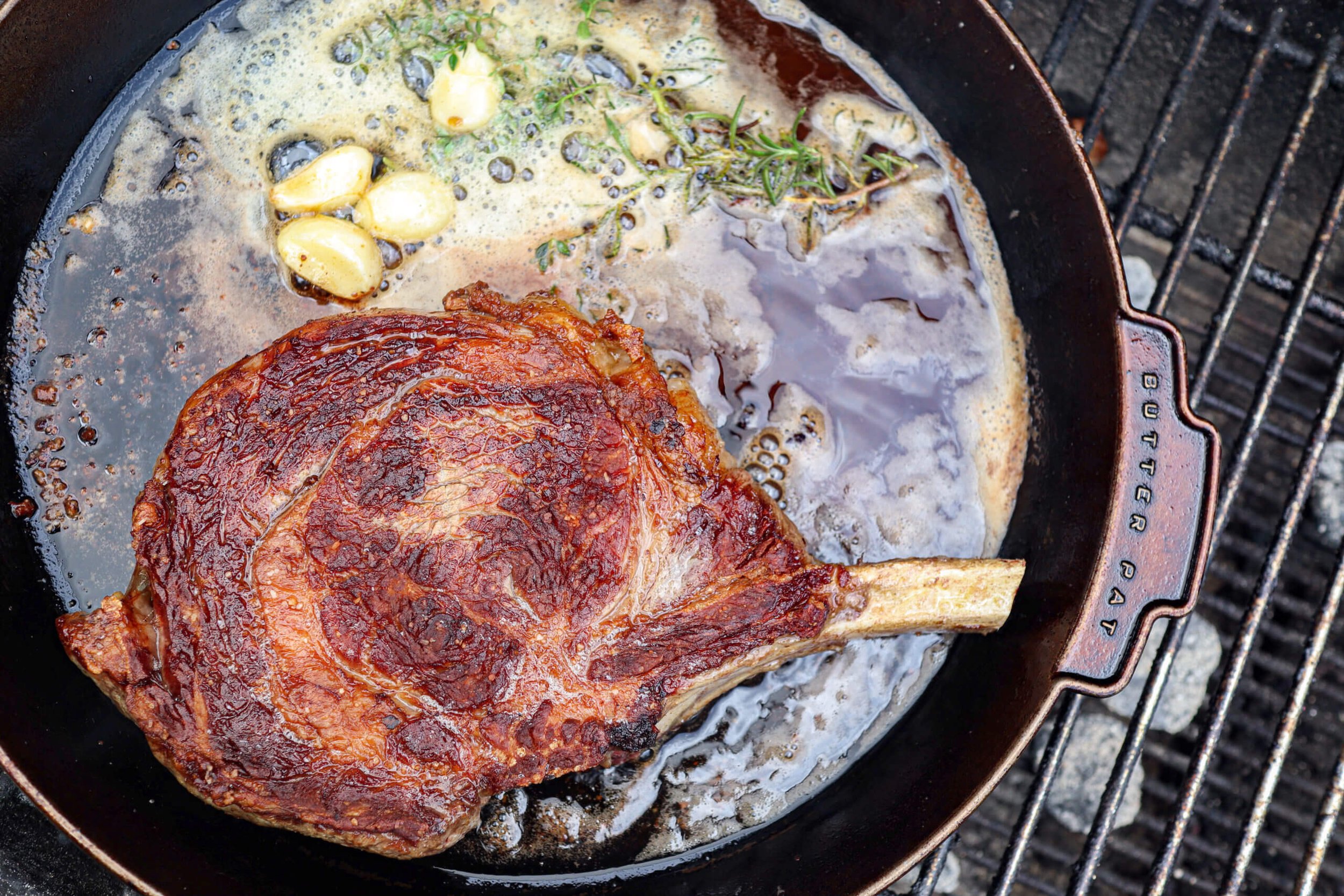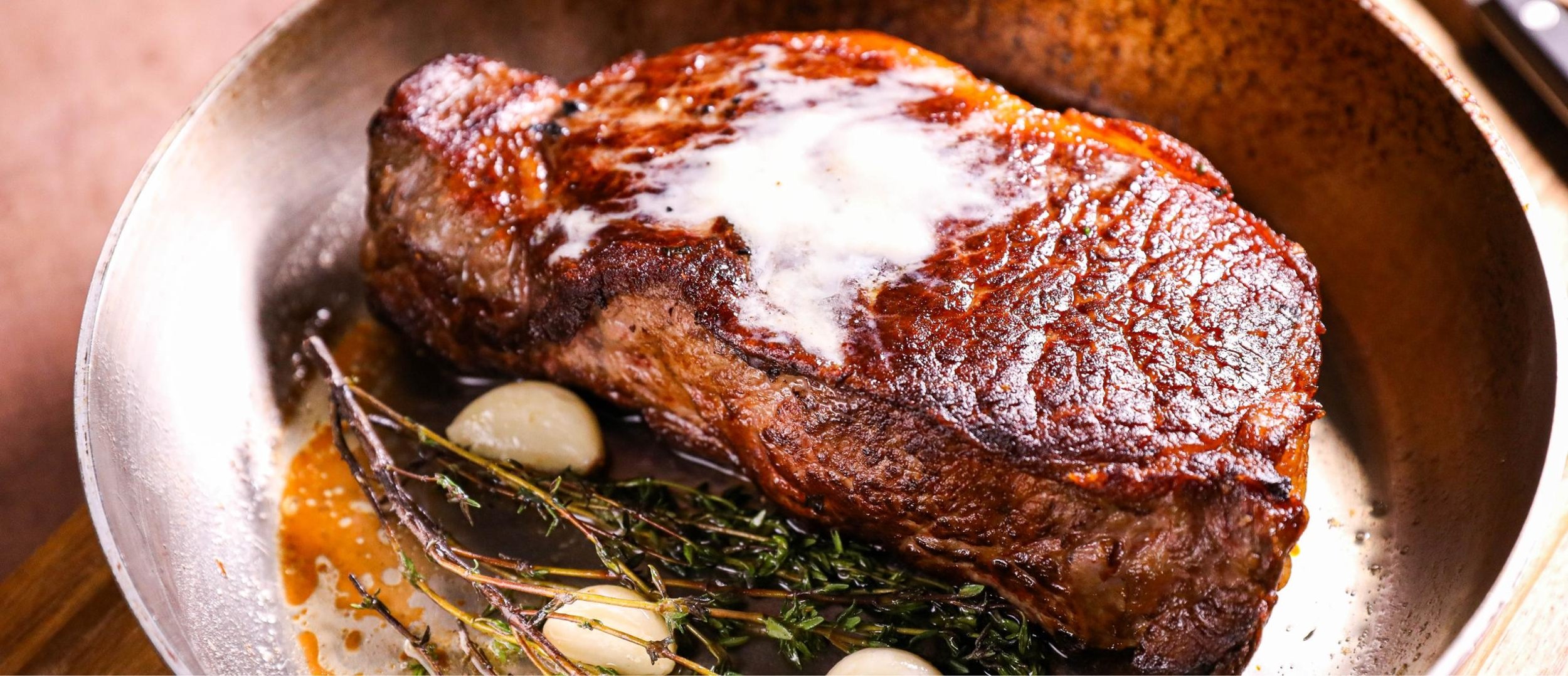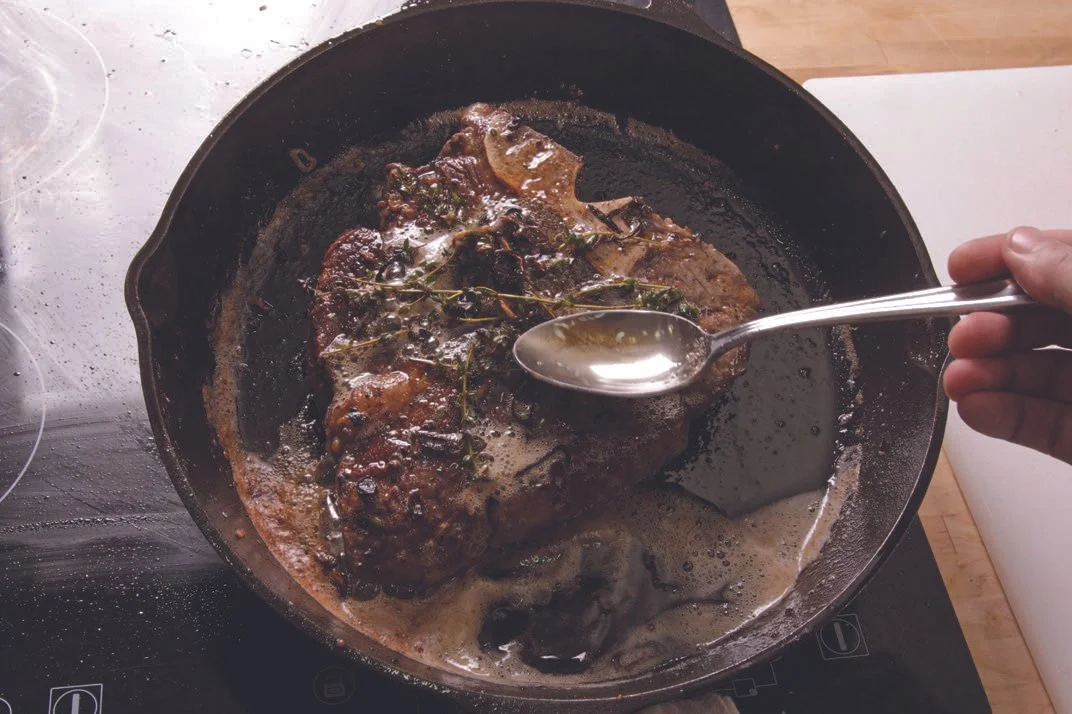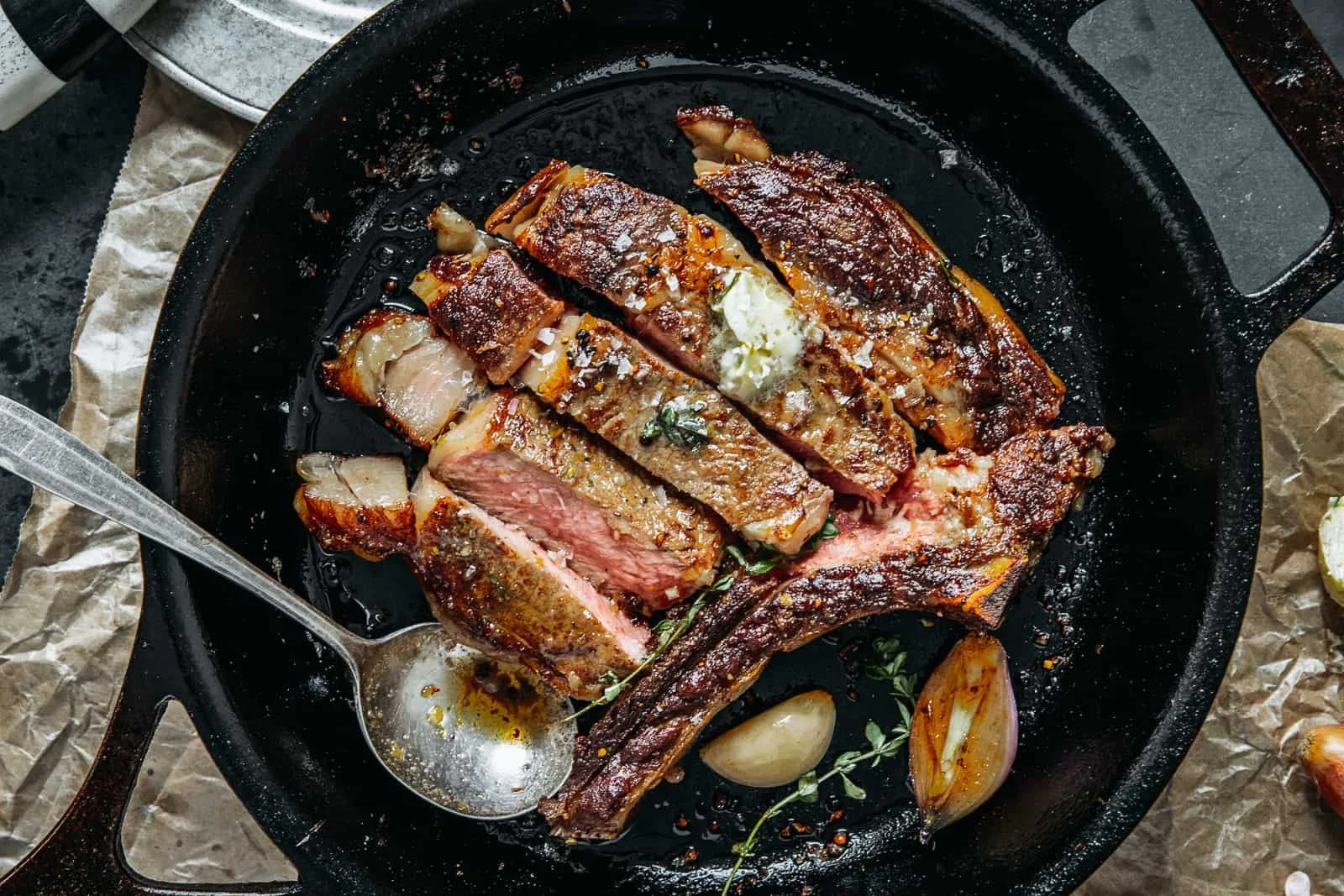How to Butter Baste Steak: Master the Technique for a Delectable Dinner
Discover > Texas Home Cooking > How to Butter Baste Steak: Master the Technique for a Delectable Dinner
Butter (how long does butter last?) basting is a technique that elevates the flavor and tenderness of a steak, creating a rich and succulent dish. This method involves continuously spooning melted butter, infused with herbs and aromatics, over the meat as it cooks. The result is a perfectly cooked steak with a deliciously caramelized crust and a tender, juicy interior.
Butter basting elevates the flavor of the grilled steak, resulting in a succulent dish with a delicious crust. With kosher salt, hot butter, and fresh rosemary, you create a personalized flavor profile. To cook steak perfectly, start with a well-seasoned, room-temperature cut and a hot skillet, ideally a cast iron pan. Vegetable oil (how long does vegetable oil last?) may also be used for preparation. The cast iron skillet is famous for its exceptional heat retention and uniform distribution, making it an essential tool for achieving a flawlessly seared and wonderfully caramelized steak.
Follow these steps, and your steak, with practice, will satisfy the pickiest eater. Unlock your culinary potential with the classic technique of butter basting.
Recognize Prime Steak Cuts
Filet Mignon is a small, tender cut from the center of the beef tenderloin (What wine goes well with beef tenderloin?). It is an excellent choice for butter basting, as the combination of the tender meat and the rich butter will create a luxurious bite every time.
New York Strip comes from the short loin area and boasts a balance of tenderness and deep beefy flavor. This cut develops a beautiful sear on the outside while staying juicy and flavorful on the inside, making it perfect for butter basting.
Ribeye is a well-marbled steak from the rib section, showcasing a rich, beefy flavor profile. The marbling helps render the fat as it cooks, making it a particularly good choice for a succulent steak dinner (What wine goes well with dinner?). Butter basting complements the meat's natural fat and enhances the overall flavor.
T-bone and Porterhouse steaks are both cut from the short loin, so they contain part of the tenderloin and strip steak connected by a T-shaped bone. The distinction between the two is the size of the tenderloin section – the Porterhouse generally has a larger tenderloin piece. Both cuts are delicious when butter-basted, as the heat will help render their built-in fats, while the butter adds an extra layer of richness and caramelization.
Selecting the right steak cut for butter basting is essential to achieve the perfect balance of flavor, texture, and tenderness. Prime cuts like Filet Mignon, New York Strip, Ribeye, T-bone, and Porterhouse are well-suited to this cooking method and will undoubtedly impress at the dinner table.
Acquire Ideal Steak Thickness
When it comes to butter-basting a steak, choosing the right thickness is essential for achieving a delicious and perfectly cooked result. The ideal thickness for a steak to be butter-basted is around 1.5 to 2 inches (3.8 to 5 cm). This thickness allows the steak to cook evenly and develop a rich, brown crust without overcooking the center.
Steaks with a thickness of 1.5 to 2 inches are usually referred to as thick-cut steaks. They provide a better balance between the crust and the interior of the steak when compared to thinner cuts. Popular thick-cut steaks suitable for butter-basting include rib-eye, New York strip, and filet mignon.
To ensure you have the ideal steak thickness, follow these steps:
Purchase steaks with a uniform thickness. When selecting your steak at the butcher or meat counter, look for cuts that are even in thickness. This will help ensure consistent cooking results.
Trim excess fat. While some fat is desirable for flavor and tenderness, too much can cause flare-ups during the cooking process. Trim any large fat deposits before cooking.
Allow the steak to come to room temperature. Before cooking, let the steak sit at room temperature for about 30 minutes. This helps the meat to cook more evenly.
By adhering to these guidelines and choosing the appropriate steak thickness, you'll be well on your way to cooking a perfectly butter-basted steak.
Seasoning Techniques
When preparing a butter-basted steak, it's essential to choose the right seasoning techniques to enhance its flavor. To achieve this, begin with a selection of high-quality spices and herbs. A well-balanced combination of seasonings not only complements the steak's rich taste but also creates an unforgettable dining experience.
Dry Rub:
A dry rub is a mixture of ground spices and herbs applied to the steak's surface before cooking. Common ingredients in a dry rub can include salt, black pepper, garlic powder, (how long does garlic powder last?) onion powder (how long does onion powder last?), and paprika. The steak should be evenly coated, ensuring ample coverage for maximum flavor. The dry rub can be applied hours in advance or just before cooking, depending on the desired intensity of the flavors.
Marinade:
For a more tender and succulent steak, marinating can be a great option. Combine liquid ingredients like olive oil, vinegar, or soy sauce (how long does soy sauce last?) with spices, herbs, or even citrus fruits like lemon, lime, or orange. Place the steak in a resealable bag or container and pour the marinade over it. Refrigerate the steak for a minimum of 30 minutes or up to 24 hours, depending on your taste preference.
Recipes for dry rub and marinade can be tweaked to cater to personal preferences. Some popular combinations include:
Dry Rub Marinade Salt, black pepper, garlic powder Olive oil, balsamic vinegar (how long does balsamic vinegar last?), rosemary Paprika, cumin, oregano, onion powder Soy sauce, ginger, garlic, green onions, brown sugar, chili powder, cayenne Red wine, garlic, thyme, Dijon mustard.
It's crucial during the cooking process to monitor the internal temperature of the steak to ensure it is cooked to the desired level of doneness. Utilizing a meat thermometer provides precision in achieving the desired outcome, and resting the cooked steak for 3 to 5 minutes before serving allows the juices to redistribute evenly.
By employing proper seasoning techniques and monitoring the cooking process, chefs can create a butter-basted steak masterpiece bursting with rich and well-rounded flavors.
Understanding Butter Basting
Butter basting is a popular cooking technique used to enhance the flavor, juiciness, and overall quality of a steak. It involves the continuous spooning of melted butter and pan juices over the steak while it cooks, resulting in a rich and flavorful crust.
Benefits of Butter Basting: The primary reason for butter basting is its ability to add flavor and tenderness to the steak. Butter contains fat, which helps break down the tough protein structures in the meat, resulting in a tender and delicious bite. Additionally, butter imparts a rich, nutty flavor that enhances the taste of the steak.
Choosing the Right Butter: For the best results, choose unsalted butter, as it allows you to better control the seasoning of the steak. Also, opt for high-quality, grass-fed butter as it typically has a higher fat content and richer flavor.
Timing Matters: The butter basting technique works best in the latter stages of the cooking process. Once the steak has developed a nice sear on both sides, reduce the heat before adding butter to the pan. This prevents the butter from burning and ensures optimal basting.
To butter-baste steak, follow these simple steps:
Sear the steak: Heat the skillet over high heat, add oil, and cook the steak on both sides until well browned. This typically takes 2-3 minutes per side, depending on the thickness of the steak.
Reduce the heat and add butter: Lower the heat to medium and add unsalted butter to the pan. Allow it to melt and slightly foam.
Begin basting: Using a spoon, carefully scoop the melted butter from the pan and pour it over the steak. Continuously baste for about 1-3 minutes, or until the steak reaches your desired level of doneness.
Rest the steak: Remove the steak from the skillet, place it on a plate, and let it rest for a few minutes before slicing and serving.
Butter basting is an effective method for elevating the taste and texture of steak, making it a favored technique among professional chefs and home cooks alike. By understanding the basics of butter basting and incorporating it into your kitchen repertoire, you can elevate your steak-cooking game to new levels of deliciousness.
The Tools You Need
Choosing the Right Pan
When butter-basting a steak, using the right pan can make all the difference. A heavy-bottomed, oven-safe pan is ideal. This will help to distribute heat evenly, which is crucial for achieving that perfect sear. Cast iron and stainless steel are the most popular choices for this purpose. Here's a quick comparison:
Material Pros Cons Cast iron Excellent heat retention, creates even sear Heavier, requires maintenance and seasoning Stainless steel Durable, versatile, easy to clean Less heat retention, can be more expensive
Avoid using non-stick pans, as they typically do not perform well at the high temperatures required for searing steak.
Utensils for Basting
To butterbaste your steak, you'll need a couple of additional utensils on hand:
A pair of tongs: These are essential for flipping the steak and keeping a firm grip on it throughout the cooking process.
A spoon or basting brush: You will need either of these to apply the melted butter onto the steak during the cooking process. A spoon is more traditional, but a basting brush can also be effective.
When butterbasting a steak, it's important to use a heavy-bottomed, oven-safe pan made of cast iron or stainless steel. A pair of tongs and a spoon or basting brush will help you ensure that your steak is cooked to perfection.
Cooking Process
Steak Preparation
Before starting the cooking process, it is essential to prepare the steak. To begin, pat the steak dry using paper towels. This step helps to remove excess moisture and allows for better browning. Then, season the steak generously with salt and pepper or your preferred seasoning mixture. Allow the seasoned steak to rest for about 30 minutes at room temperature before cooking.
Pan Heating
While the steak is resting, preheat a heavy-bottomed, oven-safe skillet or pan over medium-high heat. It is crucial to have a pan with even heat distribution for proper searing. Add a tablespoon of oil or butter to the pan and wait for it to shimmer or lightly smoke. This indicates that the fat is hot enough for searing the steak.
Basting the Steak
Once the pan is hot, gently place the seasoned steak into it, searing each side for 2-3 minutes. This will create a crust and lock in the flavors. After searing both sides, reduce the heat to medium or low, depending on the thickness of the steak.
To begin basting, add two tablespoons of butter, along with any additional flavorings such as garlic, rosemary, or thyme. As the butter melts, tilt the pan slightly, using a spoon to gather the melted butter, and pour it over the steak. Continue this basting process for about 5-7 minutes total, depending on the desired doneness of the steak.
Rare: An internal temperature of 120-125°F (about 2-3 minutes per side).
Medium-Rare: An internal temperature of 130-135°F (about 3-4 minutes per side).
Medium: An internal temperature of 140-145°F (about 4-5 minutes per side).
Well Done: An internal temperature of 160°F or higher (about 6-7 minutes per side).
Remember to use a meat thermometer to check for the steak's internal temperature. Once the steak is cooked to the desired level of doneness, remove it from the pan and allow it to rest for 5-10 minutes before cutting. This step is crucial, as it allows the juices to redistribute, resulting in a tender and juicy steak.
Remember to take the steak out of the refrigerator about 30-60 minutes before cooking, allowing it to reach room temperature, which promotes even cooking.
Steak Resting Period
A crucial step in preparing a steak is allowing it to rest after cooking. Resting the steak ensures that it will retain its juices and optimize flavor. It is generally advised to rest the steak for at least 5 minutes or up to half the cooking time for thicker cuts.
During the resting period, the steak continues to cook internally due to residual heat, a phenomenon known as carryover cooking. This also allows the meat fibers to relax and reabsorb the juices for a more tender texture. Steak should be rested on a warm plate or cutting board tented with aluminum foil, which helps to retain heat while allowing steam to escape.
Moreover, resting the steak before butter basting reduces the chance of overcooking. Butter should be added to the pan near the end of the cooking process, as the milk solids in butter can easily burn. Once the steak has rested, it can be reintroduced to the pan to be basted with the melted, sizzling butter.
To recap, the three main reasons for resting the steak are:
Retaining juices
Improving tenderness
Preventing overcooking
Pay attention to the resting period for a perfectly cooked, butter-basted steak that is full of flavor and succulent.
Serving Suggestions
Butter-basted steak is a delicious and decadent dish that can be enjoyed with a variety of side dishes and accompaniments. Here are some ideas to elevate your meal and create a well-rounded dining experience.
Classic Pairings
Many traditional combinations work well with butter-basted steak. Consider serving your steak with:
Garlic mashed potatoes
Grilled asparagus (What wine goes well with grilled asparagus?)
Creamed spinach
Steamed green beans
Caesar salad
Adventurous Complements
For a more unique and experimental twist, try pairing your steak with some of these interesting options:
Sweet potato fries with a chipotle mayo dip
Charred Brussels sprouts with bacon
Truffle macaroni and cheese
Polenta (how long do polenta last?) with mushroom ragout
Wine Selections
The rich and savory flavors in butter-basted steak call for a wine that can balance and complement the dish. Some excellent choices include:
Cabernet Sauvignon
Merlot
Syrah/Shiraz
Zinfandel
Malbec
No matter which side dishes, accompaniments, or beverages you choose, you can be confident that your butter-basted steak will be the star of the show. Enjoy experimenting with different combinations to find your favorite way to serve up this sumptuous dish.
Conclusion
Butter basting a steak is a simple, yet effective, technique to achieve a flavorful and juicy result. By using high-quality butter and following the proper steps, anyone can elevate their steak cooking skills.
First, it's essential to choose the right kind of steak and butter. Thick cuts like ribeye or strip steak ensure even cooking, while grass-fed butter imparts a rich, complex flavor. Pre-heating the pan at the perfect temperature ensures a beautiful sear, creating a crust that locks in the juices.
During the cooking process, a continuous cycle of basting the steak with the melted butter adds another layer of flavor, while also helping to cook the steak evenly. The butter should be spooned over the steak consistently, and any herbs or aromatics should be gently immersed in the butter, releasing their essential oils.
To achieve the desired doneness, a thermometer should be used to monitor the steak's internal temperature. A general guideline is 125°F for rare, 135°F for medium-rare, and 145°F for medium. Allow the steak to rest before serving to let the juices redistribute, ensuring a tender and juicy bite.
Butter basting a steak not only imparts a delicious flavor but also helps to achieve an even cook and a mouth-watering crust. By mastering this technique, one can impress friends and family with restaurant-quality steaks at home.






